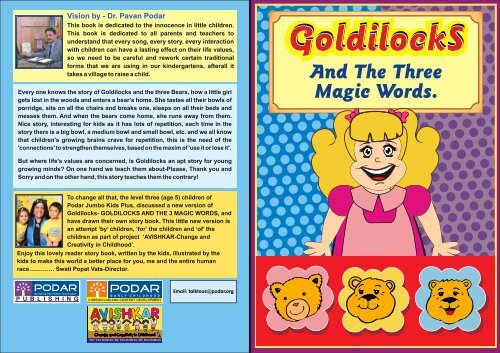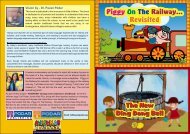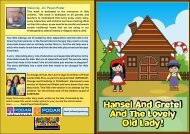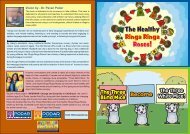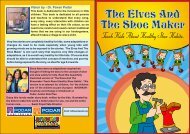goldilocks and the three magic words - Podar Jumbo Kids Plus
goldilocks and the three magic words - Podar Jumbo Kids Plus
goldilocks and the three magic words - Podar Jumbo Kids Plus
- No tags were found...
You also want an ePaper? Increase the reach of your titles
YUMPU automatically turns print PDFs into web optimized ePapers that Google loves.
Vision by - Dr. Pavan <strong>Podar</strong>This book is dedicated to <strong>the</strong> innocence in little children.This book is dedicated to all parents <strong>and</strong> teachers tounderst<strong>and</strong> that every song, every story, every interactionwith children can have a lasting effect on <strong>the</strong>ir life values,so we need to be careful <strong>and</strong> rework certain traditionalforms that we are using in our kindergartens, afterall ittakes a village to raise a child.Every one knows <strong>the</strong> story of Goldilocks <strong>and</strong> <strong>the</strong> <strong>three</strong> Bears, how a little girlgets lost in <strong>the</strong> woods <strong>and</strong> enters a bear’s home. She tastes all <strong>the</strong>ir bowls ofporridge, sits on all <strong>the</strong> chairs <strong>and</strong> breaks one, sleeps on all <strong>the</strong>ir beds <strong>and</strong>messes <strong>the</strong>m. And when <strong>the</strong> bears come home, she runs away from <strong>the</strong>m.Nice story, interesting for kids as it has lots of repetition, each time in <strong>the</strong>story <strong>the</strong>re is a big bowl, a medium bowl <strong>and</strong> small bowl, etc. <strong>and</strong> we all knowthat children's growing brains crave for repetition, this is <strong>the</strong> need of <strong>the</strong>'connections' to streng<strong>the</strong>n <strong>the</strong>mselves, based on <strong>the</strong> maxim of 'use it or lose it'.GoldilockSAnd The ThreeMagic Words.But where life's values are concerned, is Goldilocks an apt story for younggrowing minds? On one h<strong>and</strong> we teach <strong>the</strong>m about-Please, Thank you <strong>and</strong>Sorry <strong>and</strong> on <strong>the</strong> o<strong>the</strong>r h<strong>and</strong>, this story teaches <strong>the</strong>m <strong>the</strong> contrary!To change all that, <strong>the</strong> level <strong>three</strong> (age 5) children of<strong>Podar</strong> <strong>Jumbo</strong> <strong>Kids</strong> <strong>Plus</strong>, discussed a new version ofGoldilocks- GOLDILOCKS AND THE 3 MAGIC WORDS, <strong>and</strong>have drawn <strong>the</strong>ir own story book. This little new version isan attempt ‘by’ children, ‘for’ <strong>the</strong> children <strong>and</strong> ‘of’ <strong>the</strong>children as part of project ‘AVISHKAR-Change <strong>and</strong>Creativity in Childhood’.Enjoy this lovely reader story book, written by <strong>the</strong> kids, illustrated by <strong>the</strong>kids to make this world a better place for you, me <strong>and</strong> <strong>the</strong> entire humanrace…………. Swati Popat Vats-Director.E A R L Y C H I L D H O O DCURRICULUM AND CONTENT DEVELOPMENTEmail: talktous@podar.org
Why are stories important for young children?Experts in brain research confirm that warm, loving, <strong>and</strong> consistent relationshipswith adults are essential for healthy brain development in young children (Shore1997; McCain & Mustard 1999; Shonkoff & Phillips 2000; Lally & Mangione2006); <strong>and</strong> stories help build <strong>the</strong>se warm, loving <strong>and</strong> consistent relationshipsbetween adults <strong>and</strong> children both at home <strong>and</strong> at school.When stories are part of children's lives from birth, <strong>the</strong> childrenbenefit in <strong>three</strong> important ways.1. Stories enrich children's lives.2. Streng<strong>the</strong>n relationships.3. Support <strong>the</strong>ir emerging literacy skills.Stories can reflect past experience, exp<strong>and</strong> what is happening in <strong>the</strong> present,<strong>and</strong> give clues about <strong>the</strong> future. With help from sensitive <strong>and</strong> skilled adults,through stories very young children can:Access information—For example, discovering <strong>the</strong> sounds various animalsmake <strong>and</strong> what <strong>the</strong>y eat; why <strong>the</strong> wind blows; what o<strong>the</strong>r people do, think,<strong>and</strong> feel.Learn new concepts—For example, a young child's experience with cats maybe limited to one visit with her neighbor's pet, but a book about <strong>the</strong>ir differentcolors, shapes <strong>and</strong> sizes can increase her awareness <strong>and</strong> exp<strong>and</strong> heroriginal concept of what "cat" means.Learn to wonder <strong>and</strong> ask questions, <strong>and</strong> have <strong>the</strong> satisfaction of getting answersto <strong>the</strong>ir questions—for example, guessing when <strong>the</strong> adult says, "Andwhat do you think happened next?”Experience <strong>the</strong> rhythms, rhymes <strong>and</strong> beauty of language— for example inDr Sues books.Stories can also serve as ‘Discussion starters’ like; do you think Goldilockswas right? This helps children think about <strong>the</strong> stories <strong>and</strong> analyze whe<strong>the</strong>r<strong>the</strong> characters were right or wrong in <strong>the</strong>ir behavior. Discussion starters helpskids talk about <strong>the</strong>ir views <strong>and</strong> helps adults underst<strong>and</strong> <strong>the</strong> emerging thinking<strong>and</strong> moral skills in children.By responding to <strong>the</strong>ir stories this way, we are sending children <strong>the</strong> messagethat we underst<strong>and</strong> <strong>and</strong> value what <strong>the</strong>y think <strong>and</strong> say.According to experts <strong>the</strong>re are stages in ayoung child's learning to use books-Based on Schickedanz (1999).Looks attentively at pictures in a book.Recognizes a particular book.Is able to turn <strong>the</strong> pages of a board book.Points to pictures in a book.Holds a book right side up.Looks at a book from front to back, or whatever way is appropriate for<strong>the</strong> language in which <strong>the</strong> book is written <strong>and</strong> <strong>the</strong> culture from which itcomesRecognizes a book by <strong>the</strong> cover.Has a favorite story or book.Makes comments about pictures in books."Reads" <strong>the</strong> <strong>words</strong> in a book (telling <strong>the</strong> story by looking at <strong>the</strong> pictures).Uses a word or phrase that clearly comes from a book or story withwhich <strong>the</strong> child is familiar.Indicates that an adult reading a book has left out or added some<strong>words</strong> or skipped a page in a favorite story.Predicts what might happen next or what <strong>the</strong> book is about from lookingat <strong>the</strong> cover.Tells a simple story.Pretends to be "reading" to o<strong>the</strong>r children, or to a doll or teddy.Takes notice of letters <strong>and</strong> <strong>words</strong> in a book by pointing to <strong>the</strong>m or askingabout <strong>the</strong> print.
Why did we want to change <strong>the</strong> story ofGoldilocks <strong>and</strong> The Three Bears?Goldilocks goes to <strong>the</strong> house of <strong>the</strong> bears, eats withoutpermission, messes <strong>the</strong>ir house <strong>and</strong> <strong>the</strong>n runs away. Thediscussion starter on this story was, how did <strong>the</strong> bears feelwhen <strong>the</strong>y came back to <strong>the</strong>ir house <strong>and</strong> found it in amess? And we were surprised <strong>and</strong> happy, that most kidsunderstood that <strong>the</strong> bears felt upset <strong>and</strong> Baby Bear musthave cried <strong>and</strong> cried <strong>and</strong> Goldilocks should not have beenso naughty. So, our next question to <strong>the</strong>m was, so how dowe change <strong>the</strong> story so that Goldilocks is happy <strong>and</strong> soare <strong>the</strong> bears? Ideas were bounced <strong>and</strong> rejected, giggled<strong>and</strong> sometimes looked puzzled, but in <strong>the</strong> end everyoneagreed that <strong>the</strong> bears can maybe teach Goldilocks somemanners. And so emerged, ‘GOLDILOCKS AND THE 3MAGIC WORDS’.So let kids join in <strong>the</strong> journey of Goldilocks, as she learnsall about manners <strong>and</strong> being polite with <strong>the</strong> <strong>three</strong> <strong>magic</strong><strong>words</strong>- ‘Thank you’, ‘Sorry’ <strong>and</strong> ‘Please’.Learn by imitation, not prompting! And sadly prompting ismost often used while teaching kids to be polite. Mo<strong>the</strong>rsusually nag <strong>the</strong> child to 'say sorry', 'say thank you' etc. butchildren will learn best <strong>and</strong> faster if such values aremodeled to <strong>the</strong>m, instead of being told what to do. Thisstory makes <strong>the</strong> kids underst<strong>and</strong> in an interesting mannerthat even <strong>the</strong>ir favourite story book character now haslearnt to say <strong>the</strong> <strong>magic</strong> <strong>words</strong>.Level 3Rework‘Change <strong>and</strong> Creativity’to CreateGoldilocks <strong>and</strong>Three MagicWordsNotice <strong>the</strong> ‘Documentation’ in <strong>the</strong> drawings.You will notice that all <strong>the</strong> children’sdrawings have comments written by <strong>the</strong>teacher. This is called ‘documentation’; apractice adopted by us from Reggio schoolswhere a teacher asks <strong>the</strong> child about <strong>the</strong>drawings <strong>and</strong> <strong>the</strong>n writes down <strong>the</strong> pointsthat were mentioned by <strong>the</strong> child.
Goldilocks goes to <strong>the</strong> house of <strong>the</strong> bears.Goldilocks tastes <strong>the</strong> porridge in <strong>the</strong> big bowl<strong>and</strong> says, “It's too hot.”Goldilocks tastes <strong>the</strong> porridge in <strong>the</strong>medium-sized bowl <strong>and</strong> says, “It is lumpy.”Goldilocks tastes <strong>the</strong> porridge in <strong>the</strong> small bowl<strong>and</strong> says, “Hmmm, this is just right. It is yummy!”Goldilocks eats up all <strong>the</strong> porridge in <strong>the</strong> small bowl.
Goldilocks sits on <strong>the</strong> big chair <strong>and</strong> says,“This one is much too high.”Goldilocks sits on <strong>the</strong> medium-sized chair <strong>and</strong>says-, “This one is yet high.”Goldilocks sits on <strong>the</strong> small chair <strong>and</strong> says,“This one is just right for me.”When Goldilocks sits on <strong>the</strong> chair, with acreak <strong>and</strong> crack <strong>the</strong> chair fell to pieces.
Goldilocks sleeps on <strong>the</strong> big bed <strong>and</strong> says,“This one is too hard.”Goldilocks sleeps on <strong>the</strong> medium-sized bed<strong>and</strong> says, “This one is too soft.”Goldilocks sleeps on <strong>the</strong> small bed <strong>and</strong> says,“This one is so comfortable.”She goes to sleep on <strong>the</strong> bed.
When <strong>the</strong> bears come home <strong>and</strong> see <strong>the</strong> mess,Goldilocks wakes up, gets scared <strong>and</strong> runs away.Then Goldilocks meets children from'<strong>Podar</strong> <strong>Jumbo</strong> <strong>Kids</strong> <strong>Plus</strong>.’ The kids of age 5 teachGoldilocks about <strong>the</strong> <strong>three</strong> <strong>magic</strong> <strong>words</strong>-‘Please’, ‘Thank you’ <strong>and</strong> ‘Sorry’.Goldilocks realizes her mistake. She goesback to <strong>the</strong> bear's house.
Goldilocks meets Mama Bear, <strong>and</strong>says, “Please may I help you makesome more porridge?”She helps Mama Bear make moreporridge for every one.
Goldilocks <strong>the</strong>n meets Papa Bear <strong>and</strong> says,“Please teach me how to mend this chairthat I broke.”Papa Bear teaches her how to mend <strong>the</strong> chair.
She mends <strong>the</strong> chair <strong>and</strong> says“Thank you” to Papa Bear forteaching her how to mend <strong>the</strong> chair.
Goldilocks <strong>the</strong>n meets Baby Bear<strong>and</strong> says, “I am sorry I rumpledyour bed, let me help you makeit alright.”Baby Bear <strong>and</strong> Goldilocksmake <strong>the</strong> beds.
Papa Bear, Mama Bear <strong>and</strong> Baby Bearare all happy with Goldilocks.
Goldilocks promises to be a good girl<strong>and</strong> she waves <strong>the</strong>m goodbye.Goldilocks goes home. On <strong>the</strong>way she meets <strong>the</strong> kids from<strong>Podar</strong> <strong>Jumbo</strong> <strong>Kids</strong> <strong>Plus</strong>.She tells <strong>the</strong>m about her visit to<strong>the</strong> Bear's house, <strong>and</strong> how shehas used <strong>the</strong> <strong>three</strong> <strong>magic</strong> <strong>words</strong>-‘Please’, ‘Thank you’ <strong>and</strong> ‘Sorry’.The kids are happy to hear this; toge<strong>the</strong>r <strong>the</strong>y sing this song-When Goldilocks went to <strong>the</strong> house of <strong>the</strong> BearsOh what did her two eyes see?A bowl that was huge, a bowl that was small, a bowl that was tiny<strong>and</strong> that was all.She counted <strong>the</strong>m, one, two, <strong>three</strong>.When Goldilocks went to <strong>the</strong> house of <strong>the</strong> BearsOh what did her two eyes see?A chair that was too high, a chair that was high, a chair that wastiny <strong>and</strong> that was all.She counted <strong>the</strong>m, one, two, <strong>three</strong>.When Goldilocks went to <strong>the</strong> house of <strong>the</strong> BearsOh what did her two eyes see?A bed that was hard, a bed that was soft, a bed that was just right<strong>and</strong> that was all.She counted <strong>the</strong>m, one, two, <strong>three</strong>.When Goldilocks went to <strong>the</strong> house of <strong>the</strong> BearsOh what are <strong>the</strong> <strong>three</strong> <strong>words</strong> she learnt?She learnt to say ‘Please’She learnt to say ‘Sorry’She learnt to say ‘Thank you’ <strong>and</strong> that was all.These were her <strong>magic</strong> <strong>words</strong>, she counted <strong>the</strong>m one, two, <strong>three</strong>.


